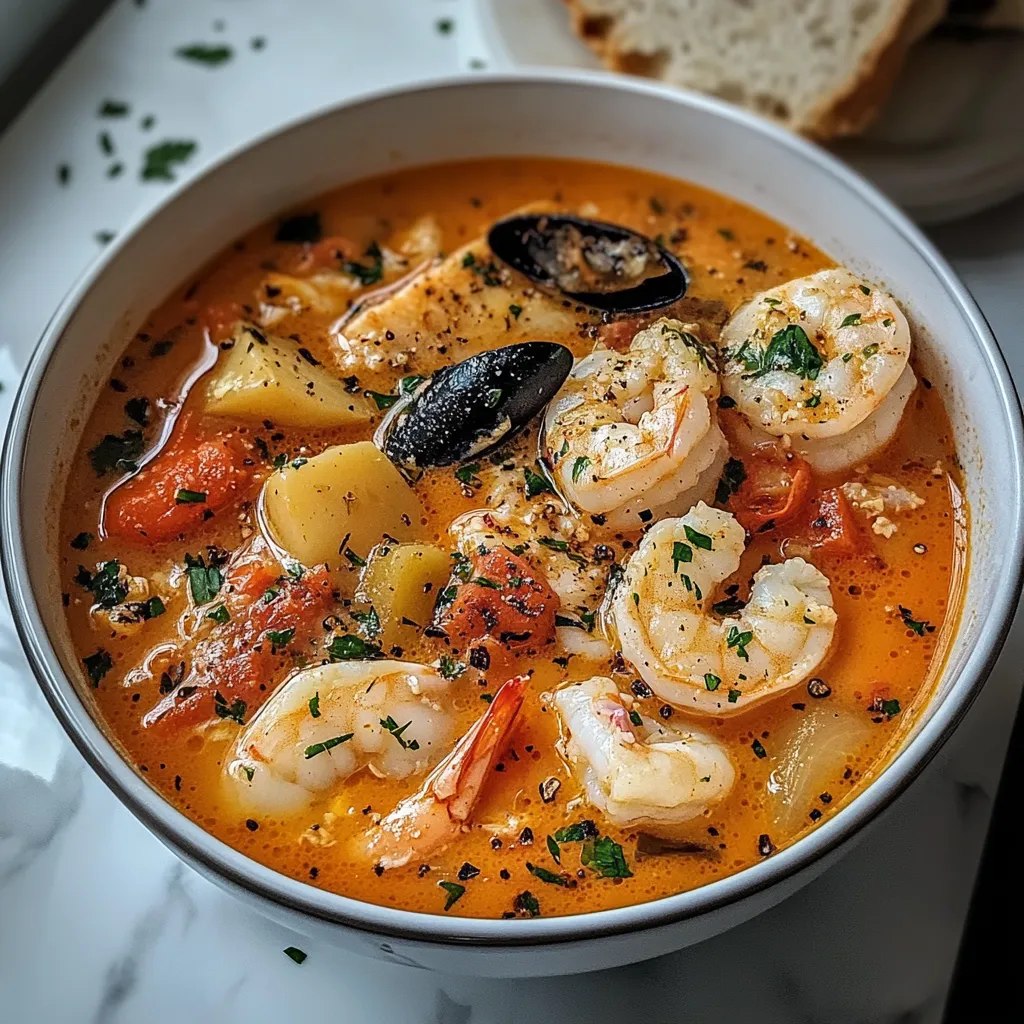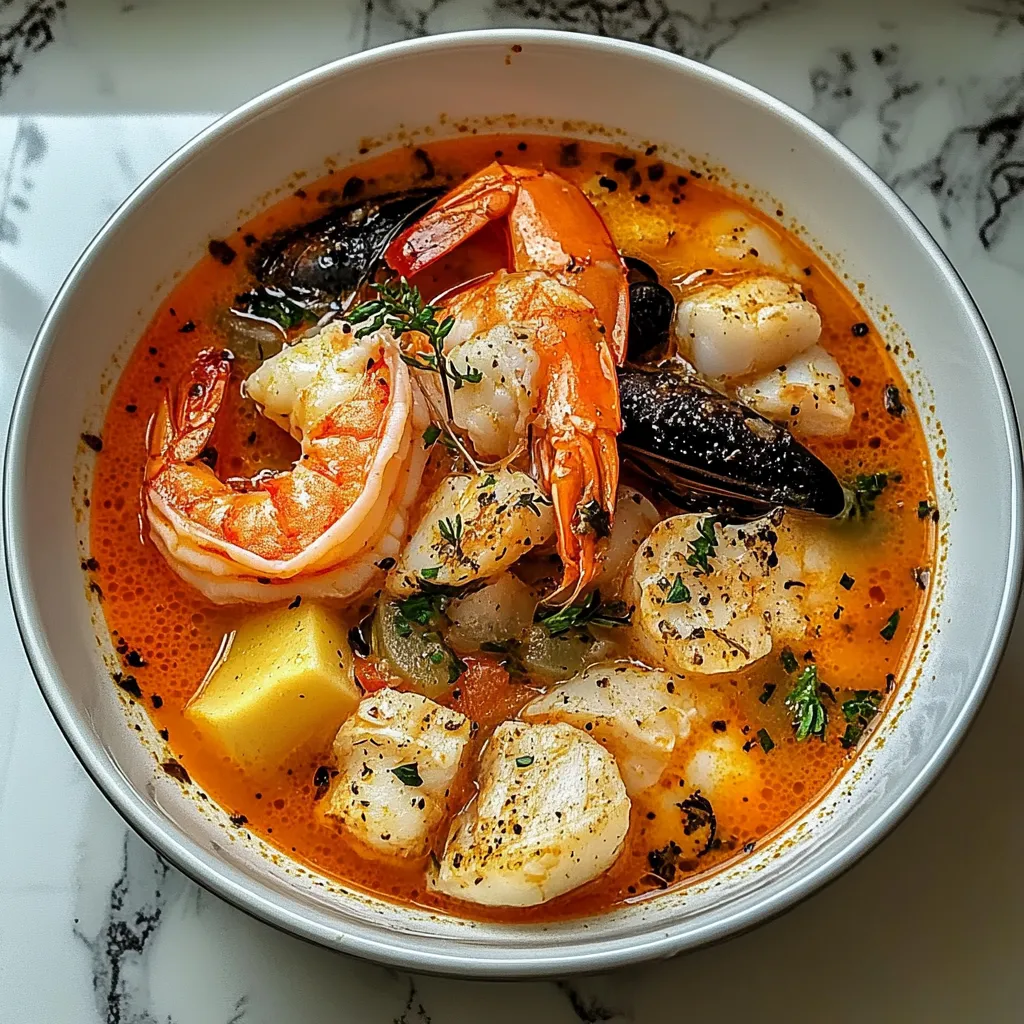 Pin it
Pin it
Bouillabaisse is that one showstopper meal that always impresses guests at my table yet feels surprisingly doable for a weekend at home. The saffron-scented broth bursting with seafood brings the flavors of Provence right into your kitchen and makes any dinner feel special.
I fell in love with bouillabaisse after tasting it in Marseille. Now every time I make this at home the scent alone transports me back to the bustling harbor with its boats and market stalls.
Ingredients
- Olive oil: Brings silky richness to the base. Use good quality extra virgin
- Onion: Adds sweetness to the broth. Choose a firm heavy onion
- Leeks: Layer in subtle earthy flavor. Look for leeks with crisp white stalks
- Garlic: Gives aromatic depth. Pick plump smooth cloves for best taste
- Fennel: Offers that signature anise note. Choose one with fresh fronds and no browning
- Diced tomatoes: Supply acidity and body. Use ripe tomatoes or good canned variety
- Fish or seafood stock: The backbone of the soup. Opt for homemade or low sodium store-bought
- Saffron threads: Essential for authentic bouillabaisse. Flavor is best from Spanish or Iranian saffron
- Dried thyme: Delivers herbal background. Use dried leaves not powdered
- Bay leaf: Adds a touch of woodsy aroma. Pick whole unbroken leaves
- Orange juice: Brightens and balances all the flavors. Fresh squeezed brings extra freshness
- Salt and pepper: Heightens all the other flavors. Use sea salt and freshly cracked pepper
- Firm white fish: Like cod, halibut, or snapper. Holds shape in the soup. Use the freshest available
- Shrimp: For sweet brininess. Choose firm seafood with no fishy smell
- Mussels or clams: Add a briny pop and complexity. Tap shellfish before cooking to test for freshness
- Squid or scallops: Optional for extra variety. Both work beautifully if you find them fresh
- Chopped parsley: Fresh color and flavor. Sprinkle right before serving
- Lemon wedges: For a final squeeze of brightness. Always slice fresh
- Crusty bread or baguette: Essential for soaking up every drop. Buy the best you can find with a good crust
Step-by-Step Instructions
- Prepare the Broth:
- Warm the olive oil in a heavy-bottomed soup pot over medium heat. Sweep in the onions, leeks, garlic, and fennel. Let the vegetables soften together for about seven minutes while stirring occasionally. You want everything to be fragrant and translucent but not browned.
- Layer the Flavors:
- Scatter in your tomatoes, followed by the saffron, dried thyme, bay leaf, and the orange juice. Stir and let this simmer for two minutes. This extra pause really lets the saffron and citrus bloom into the gentle heat.
- Build and Simmer:
- Pour in your fish or seafood stock and bring the whole mixture up to just barely boiling. Lower the heat and let the pot simmer uncovered for twenty-five minutes so the flavors deepen and meld together.
- Add the Seafood:
- Nestle the white fish chunks into the broth first. Give them about five minutes to gently poach so they do not fall apart. Gently add the shrimp, mussels or clams, and squid or scallops if using. Stir them in with care. The soup needs five to seven more minutes on a gentle simmer. Shrimp should be pink and opaque, mussels or clams must open. Discard any closed shellfish.
- Finish and Serve:
- Fish out the bay leaf before ladling the bouillabaisse into wide bowls. Top each with a shower of parsley. Squeeze some lemon if you like and always serve with a big slice of crusty bread to catch every last drop.
 Pin it
Pin it
One of my favorite moments making bouillabaisse was teaching my kids to clean mussels for the first time. Everyone ended up with wet sleeves but the laughter and pride at the table made it unforgettable. My other must-have is always a pinch more saffron for the magic it brings to the whole soup.
Storage Tips
Store any leftover bouillabaisse in a tightly covered glass container in the fridge. The flavors will deepen overnight but best to eat within two days to keep the seafood tasting its freshest. Reheat gently on the stovetop, never at a rolling boil to preserve the tender texture of each piece.
Ingredient Substitutions
If you cannot find mussels or clams, use extra shrimp or any firm white fish left at the market. Sometimes I trade fennel for celery and up the orange juice a touch for brightness. For a deeper broth, try adding a splash of dry white wine after the tomatoes.
Serving Suggestions
Bouillabaisse is always wonderful with garlicky toasted bread or a traditional Rouille sauce spread onto the slices. Add a crisp green salad on the side for contrast and a glass of Sauvignon Blanc or a Provence rosé if you want to keep the French spirit going.
Cultural Context
Bouillabaisse comes from the fishing villages along the French Mediterranean coast. The original versions used unsellable odd bits of fish simmered together with simple vegetables and local herbs. Over time it became a centerpiece for celebrations, often finished with a generous swirl of olive oil and served as both a soup and a feast.
 Pin it
Pin it
Bouillabaisse is a timeless classic that transforms humble ingredients into something magical. You'll bring the South of France right to your table.
Frequently Asked Questions
- → What types of fish are best for Bouillabaisse?
Firm white fish like cod, halibut, or snapper hold their shape in the broth and absorb the savory, aromatic flavors beautifully.
- → Can Bouillabaisse be made ahead of time?
The broth can be prepared in advance and reheated. Seafood should be added just before serving to maintain tenderness.
- → How do I prevent shellfish from overcooking?
Add shrimp, mussels, and clams towards the end, simmering only until shrimp turn pink and shells open.
- → What is the purpose of saffron in Bouillabaisse?
Saffron provides signature color and a subtle earthy aroma, enhancing the overall depth of the broth.
- → Is bread essential on the side?
Crusty bread is traditional, perfect for soaking up the flavorful broth and completing the meal experience.
